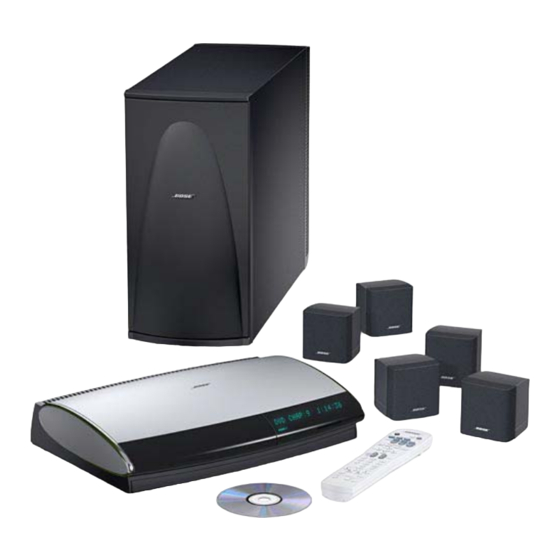Bose Lifestyle PS 18 Service Manual - Page 36
Browse online or download pdf Service Manual for Speakers Bose Lifestyle PS 18. Bose Lifestyle PS 18 43 pages. Digital acoustimass powered speakers

Test setup procedures
Place the bass module into TAP mode using the
procedures on page 26.
Note: Place all four DIP switches into the down
position before returning the unit to the cus-
tomer.
Test cable part number 264564, Figure 16, is
needed to test the bass module.
Connect the D-sub, 9 pin connector on the test
cable to the COM port on your computer.
Connect the RJ-45, 8 pin connector to the bass
module.
The bass module requires a digital audio input.
Connect the analog output of an oscillator to the
analog input of an Analog to Digital (A-D)
converter. Connect the test cable's RCA con-
nector to the A-D converter S/PDIF output.
1. Sweep Test
1.1 Issue the following TAP commands:
SO ALL D
(select all digital source inputs)
SP 5
(5 speaker mode)
VO CB 0
(set volume to full output, 0dB)
MU AMP OFF (unmute the amp)
1.2 Apply a 200 mVrms, 25 Hz signal to the
left and right input of the analog to digital (A-
D) converter. Listen for any extraneous noises
such as rubbing, scraping, or ticking.
Note: No extraneous noises such as rubbing,
scraping or ticking should be heard. To distin-
guish between normal suspension noise, rubs
and ticks, displace the woofer cone with your
finger. If the sound can be made to go away or
get worse, it's a rub or tick and the woofer
should be replaced. If the noise stays the
same, it's normal suspension noise and it will
not be heard with regular program material.
1.3 Sweep the bass module from 40 Hz to 300 Hz.
Listen carefully for any buzzes, rattles
or extraneous noises coming from the bass
module.
Note: Redress any wire or component that
buzzes.
Test Procedures
2 Bass Module Air Leak Test
2.1 Apply a 200 mVrms, 40 Hz signal to the
input of the A-D converter.
2.2 Check for air leaks from the cabinet.
Listen near the areas where the plastic seals
to the wood.
Remove the amplifier module from the bass
module assembly. Refer to the disassembly/
assembly procedures located in this manual.
Connect an 8 Ohm, 50W resistive load to the
left, center, right, left surround, and right
surround speaker outputs. Connect a 1.6
Ohm, 150W resistive load to the woofer
output, J4.
Note: Do not tie the five RCA speaker output
grounds together.
Turn the amplifier off and then place it into
TAP mode using the procedures on page 26.
Issue the TAP command: VO CB -20
(set volume output to -20dB)
Note: Because the DSP has just booted (or
rebooted) prior to being put into TAP mode
and issuing this command, the amplifier
module is now in a known state.
3. Input to Output Gain
3.1 Apply a 500 mVrms signal, at a frequency
and phase listed in the following table, to the
left and right input of the A-D converter.
Note: For a 180
positive output of a balanced output oscillator
to the negative input of the A-D converter and
the negative to the positive.
Channel
L
C
R
LS
RS
B
35
PS18/28/48 Service Manual
Test setup procedures
0
phase output, apply the
Frequency
Input
1 kHz
500 mVrms
1 kHz
500 mVrms
1 kHz
500 mVrms
1 kHz
500 mVrms
1 kHz
500 mVrms
50 Hz
500 mVrms
Phase
Right
Left
0
0
0
0
0
0
0
0
0
0
0
0
0
0
0
180
0
0
0
180
0
0
0
0
